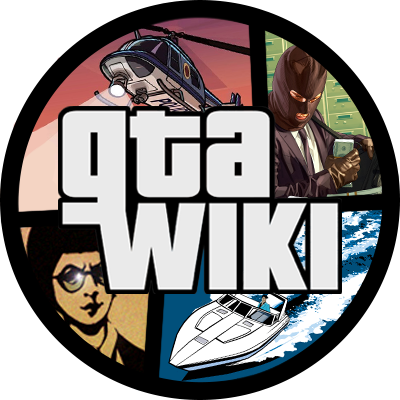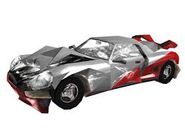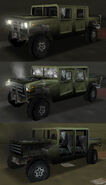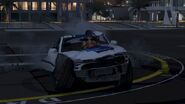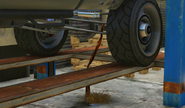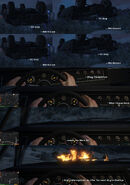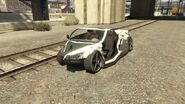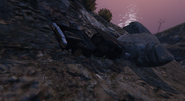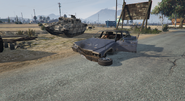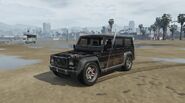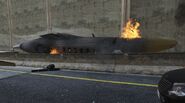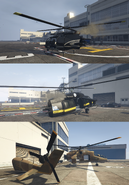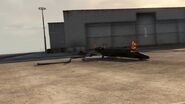Vehicle Damage is a fundamental aspect in the Grand Theft Auto series. The ability to damage and destroy vehicles has been featured in every GTA game, providing a degree of realism and challenge to the player.
Description
Throughout the series, most vehicles are susceptible to damage from the environment, typically in the form of crashes, gunfire, or other external forces, providing a certain degree of realism and illustrating the vulnerability of vehicles in the series. If a vehicle is damaged enough, it can burst into flames and explode afterwards, rendering it useless. As the series progresses, the variety of damage increases, offering additional ways in which vehicles can be destroyed. In addition, the manner in which damage is depicted in-game has changed as newer game engines are used.
Damage resistance should be considered when selecting a vehicle for a task. The high performance of certain vehicles may be offset by a weaker body, while a slow, heavy vehicle may be far more resilient to damage. If a player is not proficient in driving or has not properly planned their path to their destination, choosing a vehicle may become a hindrance if the player is trying to complete a mission within a time limit or escaping from pursuers.
Certain missions and tricks throughout the series can create a damage-resistant vehicle, which include resistance to bullets, explosions, physical collisions, and fire. Tanks and certain armored vehicles are also naturally highly resistant to damage and are invulnerable to certain forms of destructive forces, such as collisions.
2D Universe
Vehicles in Grand Theft Auto 1 and Grand Theft Auto 2 can be destroyed via high speed crashes, gunfire from firearms and drops into water, features which are still present in all later games. The games are also capable of accurately visualizing portions of vehicles which are damaged using collision detection, and each vehicle has a number of sections that represent each part as either damaged or undamaged: six in GTA 1 and four in GTA 2.
Unlike the 3D Universe games (excluding popped tyres), a vehicle's performance degrades as its damage is increasingly severe. For GTA 1, the only hint to this is a growingly louder clunking engine noise; in GTA 2 the clutch of the vehicle breaks, making the vehicle produce a loud chattering sound as it drives. A fire may start in the middle of the vehicle, which grows with increased damage or on its own over time.
3D Universe
By Grand Theft Auto III, vehicles are far more sensitive with damage, as parts can show signs of damage with the slightest collision, as well as high speed collisions with pedestrians. However, the performance of vehicles remains unaffected from damage, and imminent destruction of vehicles is represented by a burning engine. If a vehicle is flipped over, its engine will also burst into flames and result in the vehicle exploding.
GTA III's visual representation of vehicle damage improved in complexity. The engine may now emit smoke, providing a gauge on how much endurance a vehicle has left before it catches fire. Most road vehicles in the game are also constructed from individual polygons with a central "core" (the wheels, engine, chassis and body of vehicles). The damage system of vehicles represents the minor vehicle parts (doors, frontal quarter panels/headlights and bumpers) as undamaged, damaged or missing, based on collisions detected on the vehicle; the core of each vehicle remains visually unchanged despite heavy damage. Boats and aircraft, however, will not show signs of damage until they are on the verge of exploding.
Between GTA Vice City and GTA Vice City Stories, various improvements and refinements were made on GTA III's damage engine:
- For road vehicles in Grand Theft Auto: Vice City, front windscreens may now be shattered and tires can be punctured using a firearm (the latter affects handling and grip as an affected vehicle is more prone to spinouts; it also allows for the inclusion of spike strips) and melee weapons may be effectively used to damage vehicles, while trunk lids may detach from a vehicle at a certain speed if ajar; motorcycles and helicopters, which were introduced in the game, have only smoke from the engine to show damage. Smoke effects and color from the engine have also been improved to better depict the condition of a damaged vehicle (from white, to a mix of white and black, to black). Destroyed boats may also sink in the water, as do aircraft and road vehicles that have landed on water.
- Grand Theft Auto: San Andreas forgoes removable front quarter panels altogether (although headlights may still be broken if the same area is damaged), but allows bumpers to dangle before detaching. Doors may also be closed shut by physical force (i.e. swaying a vehicle side by side), making detachment of these parts far more difficult, while the lids of hoods and trunks can detach from the forces of air drag when moving at a sufficient speed. Road vehicles may also explode if its fuel intake cap is shot at, and road vehicles emit a subtle clunking sound when the smoke coming from their engine becomes a combination of white and black. Fixed-wing aircraft in the game may degrade performance-wise with increasing damage, and possess the ability to emit smoke from damaged parts (such as the wings and fuselage), while ailerons and flaps on the tail and wings may dangle for similar reasons. Airplanes and helicopters may also explode on impact with any surface. Unlike cars and motorbikes, airplanes and helicopters will explode several times upon destruction with a larger blast radius. Bicycles, which were introduced in the game, are invulnerable to damage.
- As Grand Theft Auto: Liberty City Stories and Grand Theft Auto: Vice City Stories reuse GTA Vice City's game engine, their damage engines are exactly the same as in GTA Vice City. However, like in GTA San Andreas, front quarter panels are not detachable.
Grand Theft Auto Advance, which uses an independent top-down game engine, possesses a vehicle damage engine largely similar to that of GTA 1 and GTA 2, except that large vehicles (i.e. buses and trucks) may also face the risk of rolling over when cornering at high speeds.
HD Universe
Grand Theft Auto IV
For Grand Theft Auto IV, vehicle damage has improved significantly. Imminent destruction is now represented by either a burning engine, a burning fuel tank or both, and clunking engine noises are reintroduced for vehicles with damaged engines. Alternately, the engines of severely damaged vehicles may simply cut off (this can be rectified by calling any number on the player's mobile phone); in addition, vehicles no longer catch fire and explode when they are flipped. If a car the player is not driving falls from a sufficient height, it may explode upon impact with the ground.
Instead of using readily modeled parts, GTA IV uses a more flexible damage engine that allows any part of a vehicle's body to flex and distort based on the force and direction of an impact; the body of boats and helicopters may now be damaged in this manner, while motorcycles still cannot. Players can flatten or crush any vehicle using extreme force and explosions can severely damage a vehicle's bodywork. In addition, should a road vehicle sustain severe frontal or rear damage, its axle may also bend to a point where it can no longer function, locking and dragging its wheel along the ground as the vehicle moves, greatly affecting performance. A similar effect is caused if a wheel arch is damaged to the point where it will buckle the wheel. The wheels can also crook, causing the car to pull to one side while driving, making driving in a straight line more difficult.
Other minor damages were added in the game. Individual lights (including those of motorbikes) and windows can be broken. Opened doors can be broken off by forcing them against another solid object (as doors are now registered as solid objects). Scrapes, scratches and bullet holes are added as minute damages. Flat tires can break apart at a certain speed, resulting in the wheel running on a bare rim; tires may also be destroyed by fire, burning out excessively, bullets, or extreme pressure. Vehicle bumpers can hang and bounce around from collisions or bullets. They will not detach until the vehicle explodes.
A vehicle's suspension can also be damaged. A common tactic is to partially submerge a car in water (to avoid accidental explosion) and shoot behind the wheels inside the wheel arches. There are two distinct drops in ride height for each wheel arch shot at. The newly-lowered car can be used to drift easily in a similar way to modded PC drift cars, even on consoles.
Grand Theft Auto IV also introduced the ability for vehicles to show visible stains and allow substances to accumulate on bodywork. Running into multiple pedestrians will leave bloodstains on affected areas of the vehicle, while rolling the vehicle on dirt or moist sand will leave large stains on the vehicle.
Grand Theft Auto: Chinatown Wars
In GTA Chinatown Wars, the damage system reverts to that of games prior to GTA IV, limiting visual damage to ajar doors and hood and trunk lids, and smoke or fire from the engine. Vehicles are now certain to explode after sufficient damage, and the player will also be set alight when a vehicle they have damaged heavily ignites. Flipped vehicles will also explode in the same manner as they do prior to GTA IV.
In GTA: Chinatown Wars, Baggage Handler drivers, when killed with a melee weapon, Chainsaw, or Teaser, will continuously press the gas pedal with their foot causing the vehicle to accelerate, even if it was stopped when the player was killing them.
Grand Theft Auto V
Vehicle damage in Grand Theft Auto V remains largely similar to GTA IV's, but features some differences. Vehicles' bodies are more rigid in comparison to GTA IV and wheel axles break more easily, especially when landing hard on a wheel. Engine performance can be degraded from a head-on collision with another object. Wheels can now come off if a vehicle is hit with enough force, or by landing on a wheel at a certain angle. Scratches are more visible and appear for longer compared to GTA IV. Individual lights and windows can be broken. However, if a window is broken, small shards of glass will remain protruding from the window slats, unlike GTA IV, where the whole window would break all at once. Over-revving a damaged engine (an engine spewing smoke) will cause it to go on fire. The fire will die out after several seconds, but the vehicle will no longer be driveable. The greenhouse areas of all vehicles are much stronger than in GTA IV, possibly to avoid characters' heads sticking out of the roof after a heavy impact.
Possibly due to game limitations, developer oversight or as an intended allowance for gameplay purposes, cars can still be driven after major frontal damage causing the engine bay and drive shaft to twist, where in a normal real-world situation, the crankshaft and camshaft would be heavily twisted and wouldn't be able to make a full revolution successfully. Rear-engined cars such as the Infernus can also still be driven despite strong rear impacts that should disable or damage the engine beyond repair.
It is now possible to remove front quarter panels and bumpers, whereas in GTA IV, the bumpers just dangle. Ejection through the windscreen is less common in GTA V. However, it causes much more severe damage to the player than in the previous game, often killing them outright.
It is much easier to break off doors in GTA V, as each door's physics model has been refined. Doors can be pulled off the car when negotiating a tight corner with doors open, or when trying to force the vehicle through a narrow gap in traffic or between buildings.
Cars will instantly explode if the engine or fuel tank is subjected to a very heavy impact with the terrain, typically after falling from a great height and landing nose-down. This is always fatal to the player.
The vehicle's suspension can also be damaged, lowering the car. To do this, one must shoot below the center of the wheel until it drops one or two times, this makes the car slide more making drifting easier.
Some vehicles such as the Rumpo can take a lot of damage and not explode, but leak out fuel, disabling the vehicle. Similar to GTA San Andreas, shooting the fuel cap on a vehicle will cause it to explode.
In both GTA IV and GTA V, depending on the size and speed of the vehicle, if the player crashes into a civilian's vehicle, the civilian can be killed on impact. The fatal impact is depicted when either the NPC's head hits the horn and it goes off (sometimes they leave their foot on the gas pedal and the car keeps moving) or they slump on the car seat. It is also possible to incapacitate passengers, who will slump against the dashboard, but for the driver to survive the impact, who will then attempt to hastily drive away. In GTA IV, if you hit a beater, a Dukes or Taxi (on some occasions), the NPC and car will catch fire and the car will explode.
In GTA V the Rhino tank returns again, and still has the ability to blow up cars on impact. Unlike previous generations, the Rhino usually needs to drive over vehicles to make them explode, whereas simply ramming them will usually just incapacitate the occupants. If the player drives over a car with the Rhino, the car will be crushed and will usually explode, but the Rhino itself will also explode after taking enough damage. It is also possible for the Rhino to break wheels off cars if it rolls over them fast enough to prevent the car from exploding.
In some cars, if the player damages the engine bay enough, they may see oil dripping from the engine bay. Excessive damage will eventually lead to a large amount of fuel leaking expeditiously, which will eventually cause the car to cut out due to a lack of oil causing the engine to overheat. Oil can't be ignited, unlike fuel.
GTA V also made it much easier for the trunks of vehicles to be opened as a result of damage. Shooting the trunk's lock with a weapon or repeated rear impacts will cause the trunk to fly open, much like the hood. However, it is much more difficult for the trunk's door to fall off the vehicle, due to the fact that it isn't usually placed under sufficient air resistance for its hinges to break.
Aircraft Damage
Aircraft damage has improved in Grand Theft Auto V. As with any other type of vehicle in the game, the airplane's fuselage and wings will dent and deform based on the direction and force of an impact, although the wreckage from a large airplane, such as Jet, Cargo Plane and Titan, is quite unrealistic. Ailerons in the wings and vertical stabilizer can be damaged and fall off in a collision, partially crippling the airplane and decreasing its maneuverability. Also, wings and vertical stabilizers can fall off in the event of a violent collision, rendering the aircraft useless. As with cars, the bodies of airplanes can get scraped and dented. If a light plane like the Mallard or the Velum hits the left or right wing on something solid like a building or an antenna, it will lose its wing.
If an airplane has taken a large amount of damage (from gunfire, collisions, etc.), the airplane's engine may sputter and die in mid-air, and the airplane will plummet to the ground. During this time, there will be a brief loss of power and the airplane's controls will become less responsive and more unpredictable. This can be indicated by dark black smoke coming from the engines. In the case of dual propulsion aircraft (such as the Titan), one of the engines can die with damage, and the active one starts smoking until it dies too, due to the over-revving.
Landing gears can be detached with enough force with any terrain, making landings and take-offs far more hazardous, if not flat-out crippling the aircraft's hydraulics. Aircraft and wheeled helicopters can pop tires with bullets, although this very rarely happens in-game. If an aircraft suffers burst tyres, the aircraft will be harder to turn when on the ground.
Unlike helicopters in GTA IV, which can lose the tail or the main rotor if those areas are hit with enough force, helicopters in GTA V are less likely to loose their tail but can often be crippled; if a helicopter's tail rotor has taken enough damage, usually by gunfire, it can fail, resulting in tailspin and eventually leading to the helicopter's doom.
If the player lands a helicopter too suddenly, they may damage the engines. This is revealed by having smoke pouring out of the air intakes. If the engine takes too much damage, fire will erupt from the air intakes as well.
Gallery
Trivia
General
- In some occasions, in all 3D Universe games, vehicles will explode twice when destroyed. This can be done by destroying vehicles quickly using the Minigun or a Rhino - the engine will remain on fire after the initial explosion, leading to a second soon afterwards, potentially catching player unaware. If these vehicles are entered before exploding a second time and immediately using the "full health" cheat (Or by putting out the fire by any other means), one can drive the "exploded" vehicle (Tested on Grand Theft Auto: Vice City PC, with cars only). The vehicle will drive completely normally, it will, however, look like an exploded vehicle.
- In GTA San Andreas, all bicycles are completely immune to damage. However, if a bicycle somehow ends up resting upside down, it will catch on fire and explode. This is very difficult to perform, however, because it is next to impossible to make a bike stay resting upside down.
- In GTA V, however, bicycles are not immune to damage and can be destroyed by explosives, or causing severe damage by a vehicle at high speeds.
- In the HD Universe, if a vehicle has been very heavily damaged, it may take the player a little bit longer to start the engine if it shuts off. During this time, the engine's ignition may be heard cranking multiple times, while the protagonist may utter annoyed protests such as "Come on! Start!", until the engine finally sputters to life.
- In the HD Universe, there are some moments where you land with the roof or engine and the car doesn't explode or smoke. However, if you bail out in mid-air, any vehicle will often explode upon impact.
Grand Theft Auto 2
- In GTA 2, when a vehicle begins to set on fire, it will have a small flame to start with. This smaller flame won't blow the vehicle up at all and you can keep driving the vehicle forever with no harm done. However further damage will of course cause the fire to grow, which will blow the vehicle up eventually.
Grand Theft Auto: Vice City
- In Vice City, if you enable the 'Destroy all cars on screen' cheat in the Pause Menu 15 times, a destructive effect will occur; the area of effect will increase with every subsequent use of the cheat, and within a few seconds of restarting play, destroyed cars will begin to fall out of the sky. This was also possible with trainers where you could hold the keys and due to the repeated blasts, the cars would go up beyond skybox limits and after you release it, they will fall down. The reason for this is because cars on every blast lift off the ground and fall.
- Sometimes, it is possible for a vehicle to be set on fire through external means, such as a Flamethrower, Molotov Cocktails or other stray flames in the game world, without actually exploding. Prior to GTA IV, it can be tricky to distinguish these incidental flames from those signalling an impending explosion.
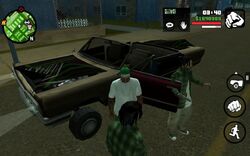
A Savanna with car parts with different colors, as seen in the mobile version.
Grand Theft Auto: San Andreas
- In GTA San Andreas, the quarter panels of the car is undamageable due to the design of the car. However, if one uses a car mod with damageable front quarter panels, it is possible to cause damage to it.
- There is a glitch in the mobile and remastered version of the game where damaged car parts will have a different color.
Grand Theft Auto: Vice City Stories
- GTA: Vice City Stories is the first game in the series to make exploded cars lose all of their 4 wheels, making it give some realism.
Grand Theft Auto IV
- In GTA IV, Due to a glitch, the player can drive a car without a wheel. the car will also miss some parts like bumpers and doors, as seen here
- If a car "breaks down" without completely stopping, then the car can be instantly restarted providing that the player doesn't release the accelerate key/button.
- A stalled car can also be restarted by rolling down a hill or by getting another player to push the car while the player is in the vehicle.
- Helicopters without tails can still be flown if the player doesn't exit the vehicle, however controlling the helicopter is significantly harder, as its ability to hover is impaired.
- Cars and trucks no longer catch fire when flipped on their roofs, which would usually happen in the 3D universe.
- Cars that have been flipped onto their side or roofs cannot be single-handedly rolled back onto their wheels however. It may require the player to push the car onto its wheels, or using the friction between touching objects to gain momentum and eventually roll the car onto its wheels.
- Rolling a vehicle during a mission often causes the mission to fail, as the car is considered unrecoverable. In certain missions, it is stated that the "vehicle was wrecked/destroyed".
- Broken down cars can be restarted by ringing a friend or contact and hanging up once the vehicle starts driving again, but does not repair the car. Further damage may cause it to break down or even catch fire.
- Crashing into another car at high speed may occasionally cause the driver of the vehicle to stumble out of the car, and on rarer occasions cause the vehicle to burst into flames.
Grand Theft Auto V
- Normal road-worthy vehicles may occasionally back-fire if damaged enough, similar to how beaters do in GTA IV.
- If the player makes a quick save whilst driving a damaged vehicle then re-loads that save, their vehicle will be fully repaired. Switching back and forth between two characters may also fix the vehicle, however some significantly rarer vehicles tend to disappear altogether when switching back. In the case of the latter, the player may spawn on foot near where the car last was, or may spawn at the nearest hospital. Cancelling a mission while in a vehicle may also fix any damage to the car.
- Overturned cars are now able to be flipped back onto their wheels using the same controls as turning. Despite the addition, remaining in an upturned car for too long during a mission may still consider the car as wrecked, thus failing the mission.
- If a twin-wheeled aircraft (Shamal, Luxor, etc.) loses its tires, only the outer wheel is popped and the inner wheel remains intact, due to it being false, similar to the second axle on trucks in the 3D Universe.
- Similar to land-vehicles, badly damaged aircraft may also stall, wherein planes may lose altitude and stall for a short period of time, and helicopters' propellers will cut out.
- In the enhanced version, due to the addition of the first person mode, the cockpit and greenhouse areas of vehicles cannot be deformed anymore than simple dents. This does not occur in the original release of GTA V, and in GTA IV.
- Despite the lack of deformation being an enhanced version-only feature, at one point deformation was removed altogether from GTA V on all platforms. This was later patched.
- Using the Director Mode in GTA V (enhanced version only), the player can still "drive" a car that has been destroyed. When the invincibility cheat is active, and explosive bullets is also active, the player can destroy a car while inside it, and remain in the seat. Using fast weaponry, the player can drive-by in the vehicle, and the explosive bullets will propel the car to move away from the bullets' direction, effectively propelling the car. This technique has been known to allow players to reach incredible speeds, and the player can still steer, albeit very limited, as the steering rack will still operate as standard. Since there is no ammo-cap in the Director Mode, this technique is effectively endless.
